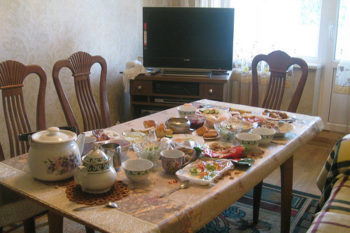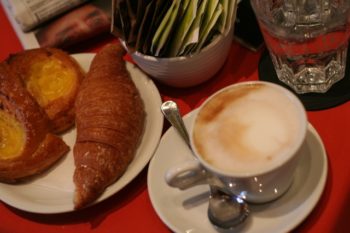I have the luck of living and working in two of the most diverse neighborhoods not just in the city of Chicago, but also the whole USA: Rogers Park and Uptown.
I was reminded of this fact by several people I met on a recent Monday night as I stopped into my favorite Rogers Park watering hole. It’s just a little neighborhood dive; cheap beer, pool table, dart boards, cracked tile, and the standard wood-paneling of any old-style American bar.
The bartender that night was Cuban-American, and I ended up in conversation with 3 Sudanese refugees. One of the Sudanese fellows wound up talking to an ethnically-mixed gentleman who grew up in Hyde Park (15+ miles away) about politics, while I spoke with his two friends about Sorghum and Millet (two types of grain very common in Africa) and the resulting beverages one can make from them… among other topics.
We were suddenly interrupted by a Mexican-American gentleman… he was either perturbed by the fact that I was speaking Spanish to the Sudanese immigrants (I was doing my best Cuban accent for them and the bartender), or that I wouldn’t speak Spanish with him.
 In any case, he had some choice Spanish words for me, and I decided to head home for the evening. I could have been upset, but the ludicrousness of the situation just made me laugh. There wasn’t a potential for cross-cultural misunderstanding… there was going to be cross-cultural misunderstanding. It was as if five drivers obeying five different sets of driving laws all ended up on the same road.
In any case, he had some choice Spanish words for me, and I decided to head home for the evening. I could have been upset, but the ludicrousness of the situation just made me laugh. There wasn’t a potential for cross-cultural misunderstanding… there was going to be cross-cultural misunderstanding. It was as if five drivers obeying five different sets of driving laws all ended up on the same road.
I returned the next day to watch a hockey game with some friends, and found six Montenegrin immigrants (former Yugoslavia) quite jovially singing traditional songs together.
I talked to the bartender, and neither of us could figure out what had made the one gentleman so upset the night before. The best part was after I left, he apparently was trying to ask the Sudanese refugees if they would “step outside… I got my people outside,” in other words, he wanted to fight. The Sudanese gentleman had been confused: “What’s outside? Why would we want to go outside?” The bartender and I had a good laugh over that one.
 In the Uptown neighborhood where I work, the maintenance staff of our building is mostly Bosnian. There’s a refugee/immigrants’ services organization that operates out of our building, and it’s not uncommon to see people in full Hijabs, Burkas, traditional Afghan dress, etc. entering and leaving the building. This is juxtaposed with a slew of “native” Chicagoans, with backgrounds typically from Poland, Germany, Ireland, Italy and other European countries, as well as a sizeable population of African Americans, and newer Mexican immigrants (and native-born Mexican-Americans). There is “Little Vietnam” just north of my office on Argyle, where you’ll find a wide plethora of Asian immigrants, and the buildings East of Sheridan road along the lake where you’ll find large numbers of retired people and dog-walking professionals living in condos.
In the Uptown neighborhood where I work, the maintenance staff of our building is mostly Bosnian. There’s a refugee/immigrants’ services organization that operates out of our building, and it’s not uncommon to see people in full Hijabs, Burkas, traditional Afghan dress, etc. entering and leaving the building. This is juxtaposed with a slew of “native” Chicagoans, with backgrounds typically from Poland, Germany, Ireland, Italy and other European countries, as well as a sizeable population of African Americans, and newer Mexican immigrants (and native-born Mexican-Americans). There is “Little Vietnam” just north of my office on Argyle, where you’ll find a wide plethora of Asian immigrants, and the buildings East of Sheridan road along the lake where you’ll find large numbers of retired people and dog-walking professionals living in condos.
 It gets confusing sometimes; elevator etiquette, for example. Many Americans would prefer to completely ignore people they see in an elevator, even if they may have ridden together dozens, or even hundreds of times. This is generally my preference too. However, there are certain US subcultures, who generally believe it is rude not to speak to people. So every so often, I’ll adopt my usual glazed-eyed stare at the wall while the elevator goes up, and I’ll hear a *cough*, and a “Well, how do you do today too sir?”, indicating displeasure with my failure to greet them or make eye contact. I’ll smile sheepishly, and say “Oh, excuse me, I’m fine, how are you?” and do my best to strike up polite conversation, usually about the weather, sports, or lately, the economy.
It gets confusing sometimes; elevator etiquette, for example. Many Americans would prefer to completely ignore people they see in an elevator, even if they may have ridden together dozens, or even hundreds of times. This is generally my preference too. However, there are certain US subcultures, who generally believe it is rude not to speak to people. So every so often, I’ll adopt my usual glazed-eyed stare at the wall while the elevator goes up, and I’ll hear a *cough*, and a “Well, how do you do today too sir?”, indicating displeasure with my failure to greet them or make eye contact. I’ll smile sheepishly, and say “Oh, excuse me, I’m fine, how are you?” and do my best to strike up polite conversation, usually about the weather, sports, or lately, the economy.
It’s inevitable. You can make your actions as contextually specific as you want, but there are simply too many cultures present at any given time to always be able to effectively communicate. You just try your best, and are prepared to laugh at the results.
 Chicago’s claim to fame has always been immigration. In horribly over-simplified order: Irish, Germans, British, Scandinavians, and Swedes; later African-Americans, Czechs, Lithuanians, Serbs, Croats, Greeks, Russian and Polish Jews, Italians, Chinese, Koreans, and Vietnamese; and more recently Mexicans, Caribbeans, Central Americans, Indians, a new smaller wave of Eastern Europeans, Africans and Middle Easterners.
Chicago’s claim to fame has always been immigration. In horribly over-simplified order: Irish, Germans, British, Scandinavians, and Swedes; later African-Americans, Czechs, Lithuanians, Serbs, Croats, Greeks, Russian and Polish Jews, Italians, Chinese, Koreans, and Vietnamese; and more recently Mexicans, Caribbeans, Central Americans, Indians, a new smaller wave of Eastern Europeans, Africans and Middle Easterners.
Neighborhoods have changed drastically in terms of main ethnic group since the early waves of immigration as well: Mexicans have replaced once-Czech Pilsen, though the East Side of Pilsen has lately become gentrified with artists and other non-Latinos. The major Puerto Rican neighborhood in the city, Humboldt Park, was previously a Jewish and Polish neighborhood, and before that, was mostly populated with Germans. Rogers Park formerly had large Jewish and Cuban populations, but is now a mix of most everybody.
Both neighborhoods have historically been points of entry for various immigrant groups, and as a result, in the stretch of Broadway and Sheridan road between them, I can buy pretty much any food product in the world. Sometimes on a Saturday, I’ll pick a recipe from a country I’ve never been to (and never cooked), and just try to find all the ingredients on my way home.
In the summertime, everyone in Rogers Park comes out to the beach, and you can listen to music from every corner of the globe, and smell all the different foods cooking on the park’s grills. Kids play soccer, football, or softball; adults sit and talk, and a few local neighborhood characters who like to sleep on the beach drink beers out in the sunshine on park benches. We don’t always all get along, but we try.
All photos courtesy of Rogers Park in 1000 words
This is Sean Oliver’s first post for PocketCultures. Why not say hello in the comments?
Sean is a project manager for Language & Culture Worldwide, a cross-cultural training and consulting firm. Sean grew up in Ohio, ending up in Chicago after extended periods in Costa Rica, Chile and California. He now has no intentions of living anywhere else; Chicago is one of his favorite places on the planet. Sean will be writing on PocketCultures mostly about American culture, and drawing attention to the vast differences between Americans across ethnicity, class, gender, generations, etc.
Read more:
The year of America: do Europeans stereotype the USA?
A photo tale of 50 states: around the USA in photos
Global migration and Europe’s population collapse





Wow. I knew that Chicago is home to a lot of immigrants, but no idea about all these different origins!
“In the summertime, everyone in Rogers Park comes out to the beach, and you can listen to music from every corner of the globe, and smell all the different foods cooking on the park’s grills.”
I love this image! So many different cultures, each bringing their own traditions to hang out in the same space.
Enjoyed the post. For additional Rogers Park/Chicago photos check out: http://thecrowsnestnoh.blogspot.com/
Also: http://www.nhna.blogspot.com/
I love the photos that you chose from my collection for your first article. I really had no idea that you would choose those particular ones.
Thank you again, and excellent article!
Sounds like a fantastic place. Although my parents are from Detroit (and I lived there twice as a child) I’ve never been down to Chicago. I hope I can check it out one day. I like how you’ve focused on relations between people and how they can be strained because of miscommunication even without knowing it. Can’t wait for your next post!
Nicely done, SeanO. I’m proud of you!
Thanks everyone! This got picked up by Lonely Planet. Yay!
You brought out the color of Uptown with your words. I live and work in Uptown myself, and have become accustomed to all the different, local dress and languages. It’s nice to read all this diversity portrayed, and be reminded of the life of this place.
Nice work Sean! I can’t wait to read more.
I live in Rogers Park, and sometimes run through that park by the lake. One day I counted at least five different language groups as I ran by all the grills and parties with local fare and kids playing. It is a beautiful thing. Thanks for capturing that SeanO